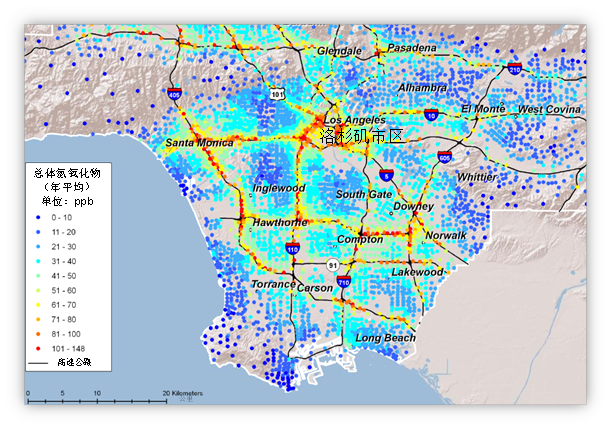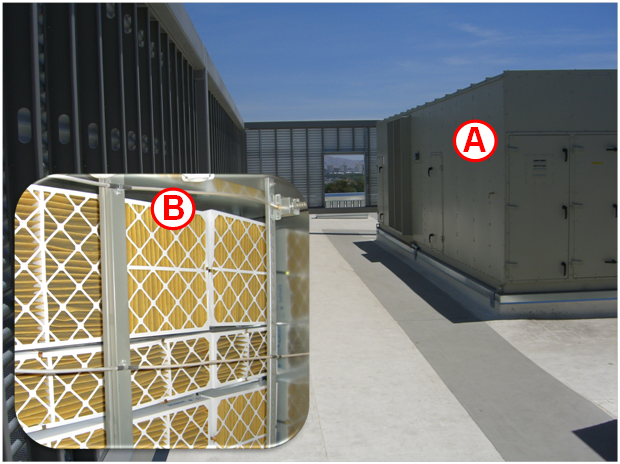路边空气污染:隐形的健康“破坏者”
2014年04月23日
作者:Song Bai(柏松), Douglas Eisinger, Ashley Russell, Fred Lurmann, Paul Roberts
原载于:《交通建设与管理》2014年4月刊
机动车排放是全球城市空气污染的一大来源。无论在发达国家还是在发展中国家,随着城市化进程不断加快,机动车数量在持续增加,交通带来的空气污染和路边暴露也越来越受到人们关注。本文将回答以下三个问题:路边空气污染浓度的实际状况如何?路边污染暴露的健康影响有哪些?如何解决路边空气污染问题以减少人体健康风险?
实际状况:主干道附近的空气污染物浓度更高
道路机动车排放各种空气污染物,如挥发性有机物(VOC)、氮氧化物(NOx)、一氧化碳(CO)和颗粒物(PM)。亚洲和其他地区的大多数国家已经制定了机动车污染排放标准,逐步降低新车的排放量。但是,多年以来高排放的老旧车辆所占车辆比例一直很高,并且一些较新的车辆也因其使用和保养情况会对环境造成污染。因此,尽管新车排放标准在不断提高,但由于道路基础设施和车辆使用迅速增长,机动车排放仍然在一个地区的空气污染物总排放量中占有很大比例。例如,2011年美国道路车辆排放的CO和NOx占全国总排放的35%至40%,而2006年中国机动车排放的CO和NOx占城市地区总排放的一半左右(40%至52%)。
道路排放的污染物扩散因当地气象和地形条件而异。然而,很多关于空气质量的研究发现,主干道附近的污染物浓度高于较远的下风处的浓度。近期一份公开发表的研究分析了来自13个国家的41份路边实测日间空气质量数据。该研究指出在世界各地的路边污染物浓度都相对较高,尤其在距离交通繁忙路段大约150米内的污染物浓度最高。研究证据还显示大多数污染物浓度在距离道路160米至570米处基本降至地区的污染背景值。
美国开展的多项研究也证实了上述路边浓度调查结果。在美国加利福尼亚州洛杉矶710号州际公路附近多个下风向抽样地点收集的测量值显示,距离公路越远,CO、黑碳(BC)和颗粒物粒子数浓度呈指数递减。据观察,在高速公路附近100米处,污染物浓度降低了60%至80%。在美国拉斯维加斯地区,沿95号高速公路测量的路边二氧化氮(NO2)浓度数据也有类似特点。
研究还发现如果在夜间日出前测量,即使在下风向较远的地方仍可监测到与道路有关的污染物浓度。由于静风和逆温等夜间条件会限制污染物扩散,研究发现在夜间高速公路上污染物的影响会扩散到2千米以外。
图1说明了美国洛杉矶地区道路交通相关污染物浓度的空间变化。该图展示了计算机模拟的区域性氮氧化物浓度,尤其显示了预测的高浓度发生在交通量大的高速公路附近。图中所示空气污染物浓度是考虑了一系列物理及化学过程的计算结果。一般来说,车流量(尤其是重型柴油车数量)、风向和风速、与道路之间的距离是路边污染物浓度水平的主要决定因素。
道路排放的污染物扩散因当地气象和地形条件而异。然而,很多关于空气质量的研究发现,主干道附近的污染物浓度高于较远的下风处的浓度。近期一份公开发表的研究分析了来自13个国家的41份路边实测日间空气质量数据。该研究指出在世界各地的路边污染物浓度都相对较高,尤其在距离交通繁忙路段大约150米内的污染物浓度最高。研究证据还显示大多数污染物浓度在距离道路160米至570米处基本降至地区的污染背景值。
美国开展的多项研究也证实了上述路边浓度调查结果。在美国加利福尼亚州洛杉矶710号州际公路附近多个下风向抽样地点收集的测量值显示,距离公路越远,CO、黑碳(BC)和颗粒物粒子数浓度呈指数递减。据观察,在高速公路附近100米处,污染物浓度降低了60%至80%。在美国拉斯维加斯地区,沿95号高速公路测量的路边二氧化氮(NO2)浓度数据也有类似特点。
研究还发现如果在夜间日出前测量,即使在下风向较远的地方仍可监测到与道路有关的污染物浓度。由于静风和逆温等夜间条件会限制污染物扩散,研究发现在夜间高速公路上污染物的影响会扩散到2千米以外。
图1说明了美国洛杉矶地区道路交通相关污染物浓度的空间变化。该图展示了计算机模拟的区域性氮氧化物浓度,尤其显示了预测的高浓度发生在交通量大的高速公路附近。图中所示空气污染物浓度是考虑了一系列物理及化学过程的计算结果。一般来说,车流量(尤其是重型柴油车数量)、风向和风速、与道路之间的距离是路边污染物浓度水平的主要决定因素。

图1.计算机模拟的美国洛杉矶地区交通污染状况,车流量大的高速公路附近污染浓度最高。
图片来源:美国索诺玛技术咨询公司 (Sonoma Technology, Inc.);该图片及分析源于一项已发表的关于路边污染与儿童哮喘疾病的研究。
图片来源:美国索诺玛技术咨询公司 (Sonoma Technology, Inc.);该图片及分析源于一项已发表的关于路边污染与儿童哮喘疾病的研究。
健康影响:暴露于路边污染会增加健康风险
大部分城市居民居住在繁忙的道路附近,尤其是有密集公路路网的区域。许多研究发现路边污染暴露和健康风险之间的相关性。美国健康影响研究所(HEI)发现道路交通引发的空气污染会加剧哮喘。在交通相关的污染暴露与心血管疾病发病率及死亡率、呼吸系统的健康问题、以及肺功能降低的因果关系上,HEI还发现了启发性的证据。最近的研究还发现路边高污染暴露与人体循环系统和冠状动脉心脏疾病的风险增加有关。其它研究也发现路边污染暴露可能与各种不利的健康影响有关。
值得注意的是路边污染暴露只是个体总污染暴露的一部分。许多人每天大部分时间是在室内和前往目的地的路上。一些研究表明,当个体在高排放车辆后面行进,其在车内受到的污染暴露会占当天污染总暴露的50%以上。对于那些每天花费大部分时间在路上或路边的人,控制与交通有关的污染将显著降低他们的健康风险。
美国的研究表明,在道路交通相关的空气污染物中,细颗粒物,特别是柴油车产生的细颗粒物(柴油颗粒物(DPM))对人体健康的不良影响最大。如图2所示,美国南加州一项名为“多种空气有毒物质暴露研究(MATES)”的长期研究项目发现柴油颗粒物暴露占城市空气污染相关的癌症风险的80%以上(South Coast Air Quality Management District,2008年)。美国犹他州盐湖城地区的空气质量研究也有类似发现。由于广泛使用柴油车,DPM暴露已引起全球关注。世界卫生组织(WHO)和美国政府已经宣布柴油颗粒物是一种致癌的空气污染物(International Agency for Research on Cancer, 2012; California Air Resources Board and California Office of Environmental Health Hazard Assessment, 1998)。
值得注意的是路边污染暴露只是个体总污染暴露的一部分。许多人每天大部分时间是在室内和前往目的地的路上。一些研究表明,当个体在高排放车辆后面行进,其在车内受到的污染暴露会占当天污染总暴露的50%以上。对于那些每天花费大部分时间在路上或路边的人,控制与交通有关的污染将显著降低他们的健康风险。
美国的研究表明,在道路交通相关的空气污染物中,细颗粒物,特别是柴油车产生的细颗粒物(柴油颗粒物(DPM))对人体健康的不良影响最大。如图2所示,美国南加州一项名为“多种空气有毒物质暴露研究(MATES)”的长期研究项目发现柴油颗粒物暴露占城市空气污染相关的癌症风险的80%以上(South Coast Air Quality Management District,2008年)。美国犹他州盐湖城地区的空气质量研究也有类似发现。由于广泛使用柴油车,DPM暴露已引起全球关注。世界卫生组织(WHO)和美国政府已经宣布柴油颗粒物是一种致癌的空气污染物(International Agency for Research on Cancer, 2012; California Air Resources Board and California Office of Environmental Health Hazard Assessment, 1998)。

图2. 在美国南加州进行的一项长期的空气有毒物质暴露研究表明,DPM是主要的有毒空气污染物,占总空气有毒物质风险的80%以上。
图片来源:数据取自2008年MATES III研究报告
链接:https://www.aqmd.gov/prdas/matesIII/MATESIIIFinalReportSept2008.html
图片来源:数据取自2008年MATES III研究报告
链接:https://www.aqmd.gov/prdas/matesIII/MATESIIIFinalReportSept2008.html
解决方案:采取降低路边污染的有效措施
鉴于路边空气污染对公众健康造成的影响,亚洲和其他地区大城市的政府部门正在考虑如何减少污染暴露。解决路边污染问题的核心理念包括:限制移动源排放,降低路边污染物浓度,以及减少人口污染暴露。各个核心理念又都包括多种方式以保护公众健康。
减少排放。从国家层面来看,采取严格的污染排放标准是减少新增车辆排放最重要的一项长期性措施。对具体的交通线路,则可以通过缓解拥堵和疏导交通的措施来减少道路车辆排放。当车辆在拥堵的道路上行驶时,“停停走走”式的行驶状况通常导致污染排放的显著增加。有研究显示,改善交通流量状况能够大大减少道路排放,具体的减排效果取决于道路特点、拥堵程度、交通流量改善对交通量增加的影响等因素。另一个减少道路排放的方法是在特定时段限制卡车出行量,或对行驶在与高利用率人行道相邻的路段的卡车进行改道。对于后者,需要对卡车改道措施进行量化评估,计算其排放影响。已有证据表明,卡车改道是城市内减少污染暴露的一项有力措施。美国圣地亚哥市某住宅区出行通道实施卡车改道措施后,街区卡车流量减少了87%,柴油颗粒物排放量减少了99%。
降低浓度。近期的实地考察与模型分析研究结果显示,路边的固体障碍物(如隔音墙)会对污染物的扩散产生影响,并能降低路边的污染物浓度。美国北卡罗来纳州开展的两项实地研究显示,在一条主干道下风向隔音墙的近后方区域,CO和超细颗粒物的浓度降低了50%。美国国家环境保护局在爱达荷州进行的一项关于空气污染物扩散的研究发现,在多种不同的大气状况下,固体隔音墙下风向的平均污染物浓度比在不设隔音墙的情况下更低。道路两旁的植被和树木也有助于减少道路附近的排放,但目前这方面的科学研究数据十分有限。植物可以阻挡、储存和过滤空气污染物。但是,一些研究显示植被的效果呈多样性和不确定性,会受到很多因素的影响,例如道路设计和配置形式、当地的气象条件、以及具体的植被特点。
减少暴露。 一般来说,将居住、工作、教育、娱乐等场所搬离到距机动车排放源较远的区域可以有效减少路边污染暴露。优化的街道配置和土地利用规划可以给人们预留缓冲区域以增加与道路的距离。比如,在进行土地利用规划时,新建或扩建的高速公路可以设置50到150米的无住宅无学校缓冲区。在爱尔兰都柏林进行的一项空气质量研究表明,行人从繁忙道路边的人行道仅移至1-2米远,受到的颗粒物和苯暴露便会下降。一个建筑若配有有效的空气过滤通风系统,可以显著降低室内污染物浓度(见图3)。美国拉斯维加斯三所学校的监测数据显示,安装了改进的过滤系统后,室内黑碳粒子浓度比室外减少了74%至97%。美国南加州的三所学校也有类似发现,安装先进的空气过滤系统可降低87%至96%的室内黑碳、超细颗粒和PM2.5浓度。许多人大部分时间都待在室内,因此室内污染物浓度控制对整体污染暴露有重要影响。
减少排放。从国家层面来看,采取严格的污染排放标准是减少新增车辆排放最重要的一项长期性措施。对具体的交通线路,则可以通过缓解拥堵和疏导交通的措施来减少道路车辆排放。当车辆在拥堵的道路上行驶时,“停停走走”式的行驶状况通常导致污染排放的显著增加。有研究显示,改善交通流量状况能够大大减少道路排放,具体的减排效果取决于道路特点、拥堵程度、交通流量改善对交通量增加的影响等因素。另一个减少道路排放的方法是在特定时段限制卡车出行量,或对行驶在与高利用率人行道相邻的路段的卡车进行改道。对于后者,需要对卡车改道措施进行量化评估,计算其排放影响。已有证据表明,卡车改道是城市内减少污染暴露的一项有力措施。美国圣地亚哥市某住宅区出行通道实施卡车改道措施后,街区卡车流量减少了87%,柴油颗粒物排放量减少了99%。
降低浓度。近期的实地考察与模型分析研究结果显示,路边的固体障碍物(如隔音墙)会对污染物的扩散产生影响,并能降低路边的污染物浓度。美国北卡罗来纳州开展的两项实地研究显示,在一条主干道下风向隔音墙的近后方区域,CO和超细颗粒物的浓度降低了50%。美国国家环境保护局在爱达荷州进行的一项关于空气污染物扩散的研究发现,在多种不同的大气状况下,固体隔音墙下风向的平均污染物浓度比在不设隔音墙的情况下更低。道路两旁的植被和树木也有助于减少道路附近的排放,但目前这方面的科学研究数据十分有限。植物可以阻挡、储存和过滤空气污染物。但是,一些研究显示植被的效果呈多样性和不确定性,会受到很多因素的影响,例如道路设计和配置形式、当地的气象条件、以及具体的植被特点。
减少暴露。 一般来说,将居住、工作、教育、娱乐等场所搬离到距机动车排放源较远的区域可以有效减少路边污染暴露。优化的街道配置和土地利用规划可以给人们预留缓冲区域以增加与道路的距离。比如,在进行土地利用规划时,新建或扩建的高速公路可以设置50到150米的无住宅无学校缓冲区。在爱尔兰都柏林进行的一项空气质量研究表明,行人从繁忙道路边的人行道仅移至1-2米远,受到的颗粒物和苯暴露便会下降。一个建筑若配有有效的空气过滤通风系统,可以显著降低室内污染物浓度(见图3)。美国拉斯维加斯三所学校的监测数据显示,安装了改进的过滤系统后,室内黑碳粒子浓度比室外减少了74%至97%。美国南加州的三所学校也有类似发现,安装先进的空气过滤系统可降低87%至96%的室内黑碳、超细颗粒和PM2.5浓度。许多人大部分时间都待在室内,因此室内污染物浓度控制对整体污染暴露有重要影响。

图3. 美国拉斯维加斯西部高中的一个改进的通风和空气过滤系统。A是学校教学楼的屋顶通风和空气过滤系统的外部。B是空气过滤系统内部的预过滤面板组,每个过滤面板尺寸约为0.6x0.6x0.1米);高效空气过滤器安装在这些预过滤面板的后方。
图片来源:美国索诺玛技术咨询公司 (Sonoma Technology, Inc.)
图片来源:美国索诺玛技术咨询公司 (Sonoma Technology, Inc.)
结论
世界各国的研究表明,主干道附近的空气污染程度较高,与道路交通有关的空气污染会造成不良的健康影响。持续的城市化进程和车辆使用让治理空气污染面临更加严峻的挑战。特别是在许多亚洲国家,机动车的数量正在快速增长(Sperling和Gordon,2008;Kutzbach,2010)。相关的政府部门可以采取措施减少排放、控制浓度和降低污染风险,个人也可以采取措施减少空气污染暴露。如果可以将本文所讨论的三方面措施结合在一起实施,效果将更加显著。因此,保护公众健康、远离路边污染的最佳途径是系统的城市规划,同时考虑交通基础设施建设和管理、路边特点、建筑设计和运营等各个方面。
参考文献:
Baldauf R., Thoma E., Khlystov A., Isakov V., Bowker G., Long T., and Snow R. (2008) Impacts of noise barriers on near-road air quality. Atmos. Environ., 42, 7502-7507.
Baldauf R., McPherson G., Wheaton L., Zhang M., Cahill T., Bailey C., Fuller C.H., Withycombe E., and Titus K. (2013) Integrating vegetation and green infrastructure into sustainable transportation planning. TR News, (288), 14-18, September-October.
California Air Resources Board and California Office of Environmental Health Hazard Assessment (1998) Executive summary for the “Proposed identification of diesel exhaust as a toxic air contaminant,” as approved by the Scientific Review Panel, April 22.
Center for Transport and Navigation (2010) Dutch air quality innovation programme concluded. Prepared by Rijkswaterstaat, Directorate-General for Public Works and Water Management, Delft, the Netherlands, January.
Dowling R., Ireson R., Skabardonis A., Gillen D., and Stopher P. (2005) Predicting air quality effects of traffic-flow improvements. Final report and user’s guide prepared by Dowling Associates, Inc., Oakland, CA, on behalf of the National Cooperative Highway Research Program of the Transportation Research Board, Washington, DC, NCHRP Project 25-21, Report 535. Available at http://trb.org/publications/nchrp/nchrp_rpt_535.pdf.
Finn D., Clawson K.L., Carter R.C., Rich J.D., Eckman R.M., Perry S.G., Isakov V., and Heist D.K. (2010) Tracer studies to characterize the effects of roadside noise barriers on near-road pollutant dispersion under varying atmospheric stability conditions. Atmos. Environ., 44, 204-214.
Fruin S., Hudda N., Eckel S., Sioutas C., Wu J., Li L., Delfino R., and Knibbs L. (2012) In-vehicle air exchange rates, inside-to-outside ratios, and exposures to traffic-related particulate air pollutants. Presented at the CARB Research Seminar, December 12, by the University of Southern California, Los Angeles, CA; University of California, Irvine, CA; and University of Technology, Brisbane, Australia.
Gan W.Q., Tamburic L., Davies H.W., Demers P.A., Koehoorn M., and Brauer M. (2010) Changes in residential proximity to road traffic and the risk of death from coronary heart disease. Epidemiology, 21(5), doi: 10.1097/EDE.0b013e3181e89f19.
Gauderman W.J., Avol E., Lurmann F., Kunzli N., Gilliland F., Peters J., and McConnell R. (2005) Childhood asthma and exposure to traffic and nitrogen dioxide. Epidemiology, 16(6), 737-743, November.
Hagler G.S.W., Lin M.-Y., Khlystov A., Baldauf R.W., Isakov V., Faircloth J., and Jackson L.E. (2012) Field investigation of roadside vegetative and structural barrier impact on near-road ultrafine particle concentrations under a variety of
wind conditions. Science of the Total Environment, 419, 7-15, doi: 10.1016/j.scitotenv.2011.12.002, March 1.
Health Effects Institute (2010) Traffic-related air pollution: a critical review of the literature on emissions, exposure, and health effects. Special Report 17, January 12. Available at http://pubs.healtheffects.org/view.php?id=334.
HEI Public Health and Air Pollution in Asia Program (2010) Public health and air pollution in Asia (PAPA): coordinated studies of short-term exposure to air pollution and daily mortality in four cities. HEI Research Report 154 prepared by the Health Effects Institute, Boston, MA, November 2010. Available at http://pubs.healtheffects.org/getfile.php?u=623.
Hu S., Fruin S., Kozawa K., Mara S., Paulson S.E., and Winer A.M. (2009) A wide area of air pollutant impact downwind of a freeway during pre-sunrise hours. Atmos. Environ., 43, 2541-2549, doi: 10.1016/j.atmosenv.2009.02.033. Available at http://www.sciencedirect.com/science/article/pii/S1352231009001617.
International Agency for Research on Cancer (2012) IARC: diesel engine exhaust carinogenic. Press release no. 213, June 12. Available at http://www.iarc.fr/en/media-centre/pr/2012/pdfs/pr213_E.pdf.
Jerrett M., Finkelstein M.M., Brook J.R., Arain M.A., Kanaroglou P., Stieb D.M., Gilbert N.L., Verma D., Finkelstein N., Chapman K.R., and Sears M.R. (2009) A cohort study of traffic-related air pollution and mortality in Toronto, Ontario, Canada. Environ. Health Persp., 117(5), 772-777, doi: 10.1289/ehp.11533, May. Available at http://www.ncbi.nlm.nih.gov/pubmed/19479020.
Kan H., Heiss G., Rose K.M., Whitsel E., Lurmann F., and London S.J. (2007) Traffic exposure and lung function in adults: the Atherosclerosis Risk in Communities study. Thorax, 62, 873–879 doi: 2010.1136/thx.2006.073015 (STI-3162), April 18.
Karner A., Eisinger D.S., Bai S., and Niemeier D. (2009) Mitigating diesel truck impacts in environmental justice communities: transportation planning and air quality in Barrio Logan, San Diego. Transportation Research Record, Journal of the Transportation Research Board, 2125, 1-8, doi: 10.3141/2125-01 (STI-3783).
Karner A., Eisinger D.S., and Niemeier D. (2010) Near-roadway air quality: synthesizing the findings from real-world data. Environ. Sci. Technol., 44, 5334-5344, doi: 10.1021/es100008x (STI-3923). Available at http://pubs.acs.org/doi/abs/10.1021/es100008x.
Kutzbach M. (2010) Megacities and megatraffic. ACCESS, 37, Fall.
Laumbach R.J. and Kipen H.M. (2012) Respiratory health effects of air pollution: update on biomass smoke and traffic pollution. J. Allergy Clin. Immunol., 129(1), 3-11.
McCarthy M.C., Ludwig J.F., Brown S.G., Vaughn D.L., and Roberts P.T. (2013) Filtration effectiveness of HVAC systems at near-roadway schools. Indoor Air, 23(3), 196-207, doi: 10.1111/ina.12015 (STI-906034-3629), January 25. Available at http://onlinelibrary.wiley.com/doi/10.1111/ina.12015/abstract.
McNabola A., Broderick B.M., and Gill L.W. (2008) Reduced exposure to air pollution on the boardwalk in Dublin, Ireland: measurement and prediction. Environment International, 34, 86-93, doi: 10.1016/j.envint.2007.07.006.
Perez L., Lurmann F., Wilson J., Pastor M., Brandt S., Kunzli N., and McConnell R. (2012) Near-roadway pollution and childhood asthma: implications for developing "win-win" compact urban development and clean vehicle strategies. Environ. Health Persp. (Published online), doi: 10.1289/ehp.1104785 (STI-5535), September 24. Available at http://ehp.niehs.nih.gov/wp-content/uploads/2012/10/ehp.1104785.pdf.
Polidori A., Fine P.M., White V., and Kwon P.S. (2013) Pilot study of high performance air filtration for classroom applications. Indoor Air, 23(3), 185-195, doi: 10.1111/ina.12013, June.
Roberts P.T., Ludwig J.F., DeWinter J.L., and Vaughn D.L. (2014) Background air quality and mitigation strategies near the Mountain View Corridor. Draft report prepared for the Mountain View Corridor Air Working Group, Utah Department of Transportation, Salt Lake City, UT, by Sonoma Technology, Petaluma, CA, and Environmental Health & Engineering, Needham, MA, STI-910051-5902-DR, February.
Rowangould G.M. (2013) A census of the US near-roadway population: public health and environmental justice considerations. Transportation Research Part D: Transport and Environment, 25, 59-67.
Rutter A.P. and Hafner H. (2012) Assessment of near-roadway NO2 concentrations. Final report prepared for the Coordinating Research Council, Inc., Alpharetta, GA, by Sonoma Technology, Inc., Petaluma, CA, CRC Report No. A-79; STI-911076-5459-FR, November 6.
South Coast Air Quality Management District (2008) MATES III final report: multiple air toxics exposure study in the South Coast Air Basin. September. Available at http://www.aqmd.gov/prdas/matesIII/matesIII.html.
Sperling D. and Gordon D.H. (2008) Two billion cars: transforming a culture. TR News, 259, 3-8, November-December.
Timoshek A., Eisinger D.S., Bai S., and Niemeier D. (2010) Mobile source air toxic emissions: sensitivity to traffic volume, fleet composition, and average speed. Transportation Research Record: Journal of the Transportation Research Board, 2158, 77-85, doi: 10.3141/2158-10 (STI-3964).
U.S. Environmental Protection Agency (2013) The 2011 National Emissions Inventory. September. Available at http://www.epa.gov/ttnchie1/net/2011inventory.html.
Volk H.E., Hertz-Picciotto I., Delwiche L., Lurmann F., and McConnell R. (2011) Residential proximity to freeways and autism in the CHARGE study. Environ. Health Persp., 119(June), 873-877, doi: 10.1289/ehp.1002835. Available at http://www.ncbi.nlm.nih.gov/pmc/articles/PMC3114825/.
Zheng B., Huo H., Zhang Q., Yao Z.L., Wang X.T., Yang X.F., Liu H., and He K.B. (2013) A new vehicle emission inventory for China with high spatial and temporal resolution. Atmos. Chem. Phys. Discuss., 13, 32005–32052, doi: 10.5194/acpd-13-32005-2013, December 9. Available at http://www.atmos-chem-phys-discuss.net/13/32005/2013/acpd-13-32005-2013-discussion.html.
Zhu Y., Hinds W.C., Kim S., Shen S., and Sioutas C. (2002) Study of ultrafine particles near a major highway with heavy-duty diesel traffic. Atmos. Environ., 36(27), 4323-4335, doi: 10.1016/s1352-2310(02)00354-0, September.
Zhu Y., Kuhn T., Mayo P., and Hinds W.C. (2006) Comparison of daytime and nighttime concentration profiles and size distributions of ultrafine particles near a major highway. Environ. Sci. Technol., 40(8), 2531-2536, doi: 10.1021/es0516514.
Baldauf R., McPherson G., Wheaton L., Zhang M., Cahill T., Bailey C., Fuller C.H., Withycombe E., and Titus K. (2013) Integrating vegetation and green infrastructure into sustainable transportation planning. TR News, (288), 14-18, September-October.
California Air Resources Board and California Office of Environmental Health Hazard Assessment (1998) Executive summary for the “Proposed identification of diesel exhaust as a toxic air contaminant,” as approved by the Scientific Review Panel, April 22.
Center for Transport and Navigation (2010) Dutch air quality innovation programme concluded. Prepared by Rijkswaterstaat, Directorate-General for Public Works and Water Management, Delft, the Netherlands, January.
Dowling R., Ireson R., Skabardonis A., Gillen D., and Stopher P. (2005) Predicting air quality effects of traffic-flow improvements. Final report and user’s guide prepared by Dowling Associates, Inc., Oakland, CA, on behalf of the National Cooperative Highway Research Program of the Transportation Research Board, Washington, DC, NCHRP Project 25-21, Report 535. Available at http://trb.org/publications/nchrp/nchrp_rpt_535.pdf.
Finn D., Clawson K.L., Carter R.C., Rich J.D., Eckman R.M., Perry S.G., Isakov V., and Heist D.K. (2010) Tracer studies to characterize the effects of roadside noise barriers on near-road pollutant dispersion under varying atmospheric stability conditions. Atmos. Environ., 44, 204-214.
Fruin S., Hudda N., Eckel S., Sioutas C., Wu J., Li L., Delfino R., and Knibbs L. (2012) In-vehicle air exchange rates, inside-to-outside ratios, and exposures to traffic-related particulate air pollutants. Presented at the CARB Research Seminar, December 12, by the University of Southern California, Los Angeles, CA; University of California, Irvine, CA; and University of Technology, Brisbane, Australia.
Gan W.Q., Tamburic L., Davies H.W., Demers P.A., Koehoorn M., and Brauer M. (2010) Changes in residential proximity to road traffic and the risk of death from coronary heart disease. Epidemiology, 21(5), doi: 10.1097/EDE.0b013e3181e89f19.
Gauderman W.J., Avol E., Lurmann F., Kunzli N., Gilliland F., Peters J., and McConnell R. (2005) Childhood asthma and exposure to traffic and nitrogen dioxide. Epidemiology, 16(6), 737-743, November.
Hagler G.S.W., Lin M.-Y., Khlystov A., Baldauf R.W., Isakov V., Faircloth J., and Jackson L.E. (2012) Field investigation of roadside vegetative and structural barrier impact on near-road ultrafine particle concentrations under a variety of
wind conditions. Science of the Total Environment, 419, 7-15, doi: 10.1016/j.scitotenv.2011.12.002, March 1.
Health Effects Institute (2010) Traffic-related air pollution: a critical review of the literature on emissions, exposure, and health effects. Special Report 17, January 12. Available at http://pubs.healtheffects.org/view.php?id=334.
HEI Public Health and Air Pollution in Asia Program (2010) Public health and air pollution in Asia (PAPA): coordinated studies of short-term exposure to air pollution and daily mortality in four cities. HEI Research Report 154 prepared by the Health Effects Institute, Boston, MA, November 2010. Available at http://pubs.healtheffects.org/getfile.php?u=623.
Hu S., Fruin S., Kozawa K., Mara S., Paulson S.E., and Winer A.M. (2009) A wide area of air pollutant impact downwind of a freeway during pre-sunrise hours. Atmos. Environ., 43, 2541-2549, doi: 10.1016/j.atmosenv.2009.02.033. Available at http://www.sciencedirect.com/science/article/pii/S1352231009001617.
International Agency for Research on Cancer (2012) IARC: diesel engine exhaust carinogenic. Press release no. 213, June 12. Available at http://www.iarc.fr/en/media-centre/pr/2012/pdfs/pr213_E.pdf.
Jerrett M., Finkelstein M.M., Brook J.R., Arain M.A., Kanaroglou P., Stieb D.M., Gilbert N.L., Verma D., Finkelstein N., Chapman K.R., and Sears M.R. (2009) A cohort study of traffic-related air pollution and mortality in Toronto, Ontario, Canada. Environ. Health Persp., 117(5), 772-777, doi: 10.1289/ehp.11533, May. Available at http://www.ncbi.nlm.nih.gov/pubmed/19479020.
Kan H., Heiss G., Rose K.M., Whitsel E., Lurmann F., and London S.J. (2007) Traffic exposure and lung function in adults: the Atherosclerosis Risk in Communities study. Thorax, 62, 873–879 doi: 2010.1136/thx.2006.073015 (STI-3162), April 18.
Karner A., Eisinger D.S., Bai S., and Niemeier D. (2009) Mitigating diesel truck impacts in environmental justice communities: transportation planning and air quality in Barrio Logan, San Diego. Transportation Research Record, Journal of the Transportation Research Board, 2125, 1-8, doi: 10.3141/2125-01 (STI-3783).
Karner A., Eisinger D.S., and Niemeier D. (2010) Near-roadway air quality: synthesizing the findings from real-world data. Environ. Sci. Technol., 44, 5334-5344, doi: 10.1021/es100008x (STI-3923). Available at http://pubs.acs.org/doi/abs/10.1021/es100008x.
Kutzbach M. (2010) Megacities and megatraffic. ACCESS, 37, Fall.
Laumbach R.J. and Kipen H.M. (2012) Respiratory health effects of air pollution: update on biomass smoke and traffic pollution. J. Allergy Clin. Immunol., 129(1), 3-11.
McCarthy M.C., Ludwig J.F., Brown S.G., Vaughn D.L., and Roberts P.T. (2013) Filtration effectiveness of HVAC systems at near-roadway schools. Indoor Air, 23(3), 196-207, doi: 10.1111/ina.12015 (STI-906034-3629), January 25. Available at http://onlinelibrary.wiley.com/doi/10.1111/ina.12015/abstract.
McNabola A., Broderick B.M., and Gill L.W. (2008) Reduced exposure to air pollution on the boardwalk in Dublin, Ireland: measurement and prediction. Environment International, 34, 86-93, doi: 10.1016/j.envint.2007.07.006.
Perez L., Lurmann F., Wilson J., Pastor M., Brandt S., Kunzli N., and McConnell R. (2012) Near-roadway pollution and childhood asthma: implications for developing "win-win" compact urban development and clean vehicle strategies. Environ. Health Persp. (Published online), doi: 10.1289/ehp.1104785 (STI-5535), September 24. Available at http://ehp.niehs.nih.gov/wp-content/uploads/2012/10/ehp.1104785.pdf.
Polidori A., Fine P.M., White V., and Kwon P.S. (2013) Pilot study of high performance air filtration for classroom applications. Indoor Air, 23(3), 185-195, doi: 10.1111/ina.12013, June.
Roberts P.T., Ludwig J.F., DeWinter J.L., and Vaughn D.L. (2014) Background air quality and mitigation strategies near the Mountain View Corridor. Draft report prepared for the Mountain View Corridor Air Working Group, Utah Department of Transportation, Salt Lake City, UT, by Sonoma Technology, Petaluma, CA, and Environmental Health & Engineering, Needham, MA, STI-910051-5902-DR, February.
Rowangould G.M. (2013) A census of the US near-roadway population: public health and environmental justice considerations. Transportation Research Part D: Transport and Environment, 25, 59-67.
Rutter A.P. and Hafner H. (2012) Assessment of near-roadway NO2 concentrations. Final report prepared for the Coordinating Research Council, Inc., Alpharetta, GA, by Sonoma Technology, Inc., Petaluma, CA, CRC Report No. A-79; STI-911076-5459-FR, November 6.
South Coast Air Quality Management District (2008) MATES III final report: multiple air toxics exposure study in the South Coast Air Basin. September. Available at http://www.aqmd.gov/prdas/matesIII/matesIII.html.
Sperling D. and Gordon D.H. (2008) Two billion cars: transforming a culture. TR News, 259, 3-8, November-December.
Timoshek A., Eisinger D.S., Bai S., and Niemeier D. (2010) Mobile source air toxic emissions: sensitivity to traffic volume, fleet composition, and average speed. Transportation Research Record: Journal of the Transportation Research Board, 2158, 77-85, doi: 10.3141/2158-10 (STI-3964).
U.S. Environmental Protection Agency (2013) The 2011 National Emissions Inventory. September. Available at http://www.epa.gov/ttnchie1/net/2011inventory.html.
Volk H.E., Hertz-Picciotto I., Delwiche L., Lurmann F., and McConnell R. (2011) Residential proximity to freeways and autism in the CHARGE study. Environ. Health Persp., 119(June), 873-877, doi: 10.1289/ehp.1002835. Available at http://www.ncbi.nlm.nih.gov/pmc/articles/PMC3114825/.
Zheng B., Huo H., Zhang Q., Yao Z.L., Wang X.T., Yang X.F., Liu H., and He K.B. (2013) A new vehicle emission inventory for China with high spatial and temporal resolution. Atmos. Chem. Phys. Discuss., 13, 32005–32052, doi: 10.5194/acpd-13-32005-2013, December 9. Available at http://www.atmos-chem-phys-discuss.net/13/32005/2013/acpd-13-32005-2013-discussion.html.
Zhu Y., Hinds W.C., Kim S., Shen S., and Sioutas C. (2002) Study of ultrafine particles near a major highway with heavy-duty diesel traffic. Atmos. Environ., 36(27), 4323-4335, doi: 10.1016/s1352-2310(02)00354-0, September.
Zhu Y., Kuhn T., Mayo P., and Hinds W.C. (2006) Comparison of daytime and nighttime concentration profiles and size distributions of ultrafine particles near a major highway. Environ. Sci. Technol., 40(8), 2531-2536, doi: 10.1021/es0516514.



